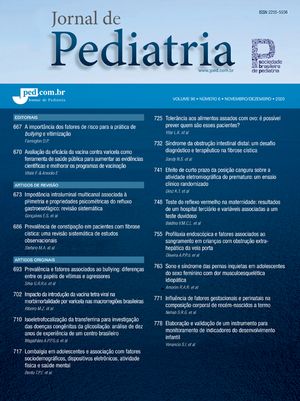
To review practical questions about the initial assistance and follow-up of child abuse victims and their families by pediatricians.
Sources of dataA literature review was carried out using the MEDLINE and LILACS databases, including the years 2000 to 2005. Some articles from past years and books were included due to their importance.
Summary of the findingsInitial assistance is one of the most important actions by health professionals for the protection of abused children in different healthcare sectors (community, outpatient clinics, emergency rooms and infirmary), and it is fundamental for the reduction of immediate and long-term negative consequences of violence. The protection services cannot monitor all the families under their responsibility and most child abuse cases are not even reported to those institutions; therefore, regular follow-up by a pediatrician is advisable. It is important to provide the family with support and guidance until the child is safe. The main challenges are: to be involved without causing more violence; to consider all the family as the focus of attention, including the family members who have committed the assault, helping them to change inadequate behaviors; to develop specific abilities to carry out this work, which must be multiprofessional, interdisciplinary and intersectoral.
ConclusionFamilies face difficulties when their children are abused and when the situation gains notoriety, demanding interventions from many institutions. In this process, a pediatrician can guide and help them to guarantee the protection and healthy development of their children. To overcome challenges, health professionals have to be technically and emotionally prepared.
Revisar questões práticas voltadas para o acolhimento e acompanhamento pediátricos de crianças vítimas de violência e de suas famílias.
Fontes dos dadosRevisão de literatura a partir dos bancos de dados MEDLINE e LILACS, anos 2000 a 2005. Foram incluídos, por sua relevância, alguns artigos de anos anteriores e livros.
Síntese dos dadosDentre as ações do profissional de saúde para a proteção da criança vitimizada, destaca-se o acolhimento nos diversos setores da atenção (comunidade, ambulatório, emergência e enfermaria), fundamental para diminuir as conseqüências negativas imediatas e de longo prazo causadas pela violência. As instituições de proteção não conseguem monitorar todas as famílias sob sua responsabilidade, e a maior parte dos casos de maus-tratos sequer chega ao conhecimento desses órgãos, sendo aconselhável a manutenção do acompanhamento pediátrico. Deve-se garantir apoio e orientação à família até que a criança esteja em segurança. Os principais desafios são: envolver-se sem gerar mais violência; ter toda a família como alvo da atenção, incluindo familiares que cometeram a agressão, auxiliando-os a mudar comportamentos inadequados; desenvolver habilidades específicas para esse tipo de trabalho, o qual deve ser multiprofissional, interdisciplinar e intersetorial.
ConclusõesAs famílias enfrentam dificuldades quando suas crianças sofrem violência e também quando a situação se torna pública, passando a demandar intervenções de diversas instituições. Nesse processo, o pediatra pode orientá-las e auxiliá-las a garantir a proteção e o desenvolvimento saudável da criança. Para superar os desafios dessa missão, o profissional precisa estar preparado técnica e emocionalmente.








